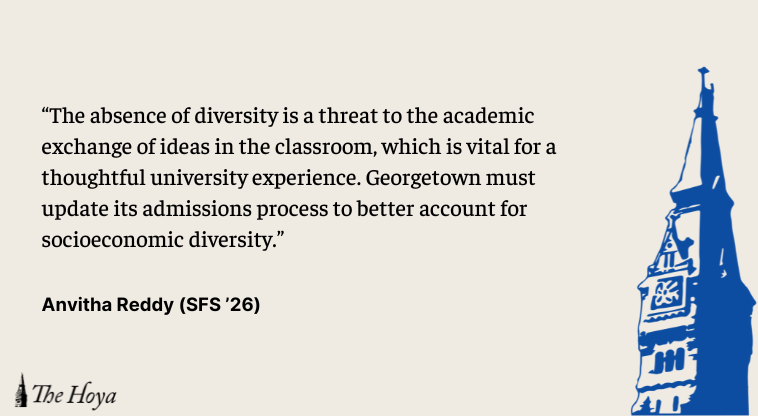In my first year at Georgetown University, I’ve had the privilege of giving tours to hundreds of prospective students and families. A disproportionately large number of questions I receive relate to Georgetown’s affordability, history of wealth and socioeconomic concerns.
These concerns are a reflection of a problem already known to Georgetown students. Almost three-fourths of Georgetown students are in the top 20% of income-earning families. Furthermore, Georgetown ranks sixth in the nation for the wealthiest student body.
The absence of diversity is a threat to the academic exchange of ideas in the classroom, which is vital for a thoughtful university experience. Georgetown must update its admissions process to better account for socioeconomic diversity.
Compared to peer institutions, like Notre Dame University and Vanderbilt University, Georgetown ranks alarmingly high in its proportion of wealthy students.
Part of this inequality stems from Georgetown’s unique application process. Georgetown is one of the few institutions nationwide that does not use the Common Application (Common App), a portal home to more than 1,000 colleges. Rather, Georgetown uses its own application portal, effectively isolating itself from other colleges in the application process.
Georgetown’s absence from the Common App first creates a financial barrier for applicants, as a $75 fee is due before students can even view the application questions. In contrast, the Common App only requires university-specific fees upon submission.
Georgetown cites its decision to stay off the Common App as an effort to create a pool of students genuinely interested in the university, allowing the university to maintain a higher acceptance rate. Nevertheless, this decision hinders Georgetown’s ability to gain name recognition in lower-income communities.
Staying off the Common App makes Georgetown a not-as-common option in college application discussions for these groups.
Georgetown must use the Common App because high-achieving students from low-income families would be more likely to apply. Moreover, simply scrolling through the Common App portal would introduce these students to Georgetown, as opposed to them having to seek out the application on their own.
Another potential barrier is financial aid.
Georgetown meets 100% of the demonstrated financial needs of applicants and practices a need-blind financial aid process, but this doesn’t guarantee financial aid to international students who would otherwise qualify — an imperfect policy.
However, due to Georgetown’s relatively low endowment compared to other top 20 schools, the amount of money available for financial aid from the endowment is limited. Although the university could increase that figure, it would have to decrease its spending in other areas.
Although Georgetown allocates 25% of its $1.5 billion endowment to “student aid,” more than Harvard University 19%, Harvard’s endowment is 20 times larger than Georgetown’s. Therefore, Harvard is significantly more generous in their financial aid packages.
There is, however, a solution to Georgetown’s endowment woes; namely, the university should increase its annual draw rate — the amount of money the university is able to use — in order to invest in its students.
Currently, the average college endowment has about a 5% draw rate, meaning that only 5% of an endowment is eligible to be spent annually. By increasing its annual draw rate by just half a percentage point, Georgetown could allocate several million more dollars for financial aid.
President John DeGioia (CAS ’79, GRD ’95) stated in an interview with The Hoya that the Office of Undergraduate Admissions would use socioeconomic status as a proxy in the wake of the Supreme Court’s decision to strike down affirmative action. Georgetown’s recognition of the value of socioeconomic diversity could be indicative of reform in its admissions processes.
Georgetown — one of the most expensive schools in the country — now faces the responsibility of making its education more accessible to low-income students. The university must make tuition more affordable and reduce barriers in its application process by joining the Common App. In addition, the university must allocate more funds for financial aid.
Anvitha Reddy is a sophomore in the School of Foreign Service. This is the first installment of her column, Money Talks.














